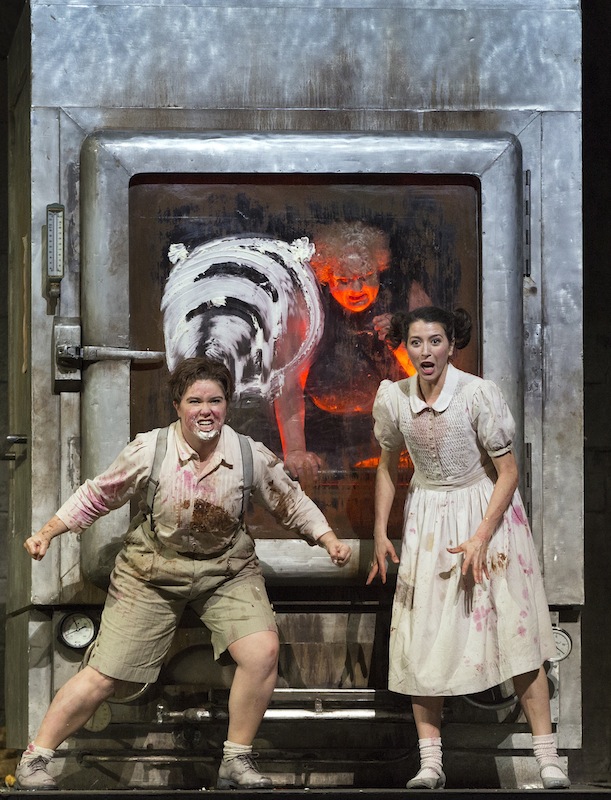Met’s colorful, if gruesome, “Hansel and Gretel” returns with its seasonal “magic”

Tara Erraught and Lisette Oropesa in the title roles with Gerhard Siegel as the Witch in Humperdinck’s “Hansel and Gretel” at the Metropolitan Opera. Photo: Marty Sohl.
The Metropolitan Opera opened its holiday run of Humperdinck’s Hansel and Gretel Monday night with singing, acting, staging and orchestral playing that was good enough to interest young listeners in coming back to the opera house for more.
A full house consisting largely of children and their parents—the under-16 set numbering about four girls to every boy—drank in John Macfarlane’s fanciful sets and costumes and Humperdinck’s fetching score, packed with tunes Disney would envy.
Soprano Lisette Oropesa as Gretel sang with slimmed-down, girlish tone in the early scenes, limiting her projection of words and emotions, but found her dramatic mojo (and piercing high notes) in the climactic final act.
Tara Erraught’s warmer mezzo-soprano gave Hansel that extra touch of male heft and self-importance, as the two singers convincingly enacted the special relationship of siblings, turning on a dime from rivalry to best-friends-forever and back again.
In a part that gently parodies Humperdinck’s idol Wagner, mezzo-soprano Delora Zajick as the mother Gertrude fired off some Fricka-like rage at her children’s laziness with household chores, then settled into a poverty-induced, depressive funk that was as drab as her shapeless gray costume.
In contrast, Quinn Kelsey was a picture of good humor (and mild tipsiness) as the father and broommaker Peter, celebrating a big broom sale that was putting food on the family table. His forward-placed but ample baritone sent words and music into the large house with unmatched clarity.
Tenor Gerhard Siegel was a large physical and vocal presence as the Witch, who came off as a bit eccentric but all too human, considering her eventual fate of being roasted and eaten by the rest of the cast.
In their brief roles, sopranos Rihab Chaieb as the comforting, sleep-inducing Sandman and Hyesang Park as the sparkly Dew Fairy (the kid’s wake-up call the next morning) reminded listeners that pretty voices are a major reason one goes to the opera.
Conductor Donald Runnicles and the Met orchestra were at their best when supporting the singers and weaving a fairy-tale ambiance around the action. (Even at the story’s darkest moments, Humperdinck’s airy score reminded listeners not to take any of it too seriously.) They fared less well on their own in the prelude and the entr’acte, which sounded somewhat dull and studied.
The Met’s Children’s Chorus, directed by Anthony Piccolo, was suitably ethereal as forest echoes in Act II and robust as revived victims of the Witch at the opera’s close.
As for the production itself, critiquing a well-traveled show that is entering its second decade and already something of a civic institution is like evaluating how the sun comes up in the morning—it’s going to happen no matter what we say.
Opera in English for an English-speaking audience is a worthy endeavor, and David Pountney’s idiomatically British version was charming, but the size of the Met auditorium makes sung text mostly unintelligible in any language, so using the seat-back titles—or even better, reading up on a synopsis or libretto in advance—is recommended for listeners of all ages. It’s worth cultivating that pre-opera habit from the start in any case.
Young viewers may have found the opening kitchen scene in its cramped setting a little like watching a TV show in black-and-white on a 12-inch set, but things picked up after that. The dream of 14 angels that closes Act II—transformed here into 14 giant chefs and a fish-headed butler serving the hungry kids a sumptuous meal, amid Humperdinck’s radiant music and Jennifer Tipton’s fantastic lighting—became this production’s enchanting Nutcracker moment.
In its pursuit of physical comedy and “steampunk” industrial atmosphere, the closing act had many staging flaws—action that contradicted what the characters were saying, for example, and fumbling the climactic moment of pushing the Witch into the oven.
More troubling than that, the ending is far more gruesome than called for in the libretto, with the Witch seen writhing in red light behind the oven’s glass door, then served to the children not as a gingerbread lady but as the realistic charred corpse of a woman, while the cast sings a hymn of thanksgiving to God.
Some young viewers may laugh all this off as amusingly gory fantasy, but the more sensitive ones—which would have included this reviewer at that age—could have nightmares for weeks.
So count this review as a recommendation, with some cautions, to get out and have some family fun at the opera house this holiday season.
Hansel and Gretel will be repeated with some cast changes through January 6. metopera.org; 212-362-2000.







Posted Dec 27, 2017 at 12:23 am by Ladytn
The costume of Delora Zajick, the mother Gertrude character, consists of a modern gray cashmere sweater and jacket with bottons and a cotton beige long skirt. It hurt my eyes just watching her inappropriate outfit. Plus, she spits the sausage she chewed in the sink. Gross!
Posted Jan 07, 2018 at 3:46 pm by gail e
purely sacreligious . hansel and greetel modernized… yuck… hated it… couldn’t understand the lyrics… missed the lederhosen , gingerbread, german, and everything else that i remember from years past. shame on the powers that be.. what were you thinking?